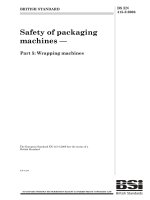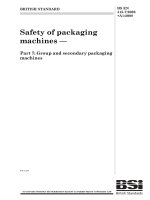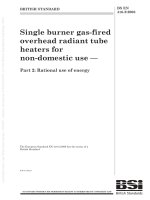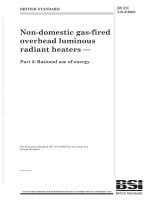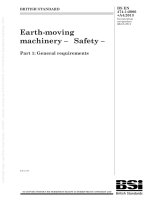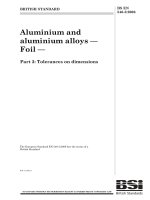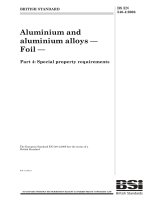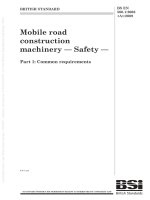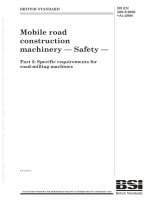Bsi bs en 14175 6 2006 (2014)
Bạn đang xem bản rút gọn của tài liệu. Xem và tải ngay bản đầy đủ của tài liệu tại đây (870.25 KB, 30 trang )
BRITISH STANDARD
BS EN
14175-6:2006
Incorporating
corrigendum
January 2014
Fume cupboards —
Part 6: Variable air volume fume
cupboards
ICS 71.040.10; 91.140.30
BS EN 14175-6:2006
National foreword
This British Standard is the UK implementation of EN 14175-6:2006. Together
with BS EN 14175-1:2003, BS EN 14175-2:2003, BS EN 14175-3:2003,
BS EN 14175-4:2004 and DD CEN/TS 14175-5:2006, BS EN 14175-7:2012,
it supersedes BS 7258-1:1994, BS 7258-2:1994, BS 7258-3:1994 and
BS 7258-4:1994 which are withdrawn.
The UK committee advises that prior to purchasing a fume cupboard, a risk
assessment should be performed to assess the risks associated with the
substances that are to be manipulated. This would ensure that the fume
cupboard is suitable for its intended purpose and that current exposure
limits for toxic substances are not exceeded. It is suggested, therefore, that
users may need to draw up a specification appropriate to their particular
requirements, within the overall permissible limits of this standard and the
information on installation included in the National Annex. For users with
little experience of purchasing fume cupboards, it may be helpful for trade
associations, employers’ bodies or other organizations associated with a
particular activity to give guidance on a suitable specification. An example
would be Building Bulletin 88 from the Architects & Building Branch of the
Department for Education and Employment, which is currently under revision
and to be published in future as G9a Fume Cupboards in Schools by
CLEAPSS.
The UK participation in its preparation was entrusted by Technical Committee
LBI/1, Laboratory safety and equipment, to subcommittee LBI/1/1, Laboratory
furniture and fittings.
A list of organizations represented on LBI/1/1 can be obtained on request to its
secretary.
This publication does not purport to include all the necessary provisions of a
contract. Users are responsible for its correct application.
Compliance with a British Standard cannot confer immunity from
legal obligations.
This British Standard was
published under the authority
of the Standards Policy and
Strategy Committee
on 30 March 2007
© The British Standards
Institution 2014. Published
by BSI Standards Limited
2014
ISBN 978 0 580 84315 0
Amendments/corrigenda issued since publication
Date
Comments
31 January 2014
Correction to supersession details and national
foreword
EN 14175-6
EUROPEAN STANDARD
NORME EUROPÉENNE
EUROPÄISCHE NORM
May 2006
ICS 71.040.10
English Version
Fume cupboards - Part 6: Variable air volume fume cupboards
Sorbonnes - Partie 6 : Sorbonnes à débit d'air variable
Abzüge - Teil 6: Abzüge mit variablem Luftstrom
This European Standard was approved by CEN on 3 April 2006.
CEN members are bound to comply with the CEN/CENELEC Internal Regulations which stipulate the conditions for giving this European
Standard the status of a national standard without any alteration. Up-to-date lists and bibliographical references concerning such national
standards may be obtained on application to the Central Secretariat or to any CEN member.
This European Standard exists in three official versions (English, French, German). A version in any other language made by translation
under the responsibility of a CEN member into its own language and notified to the Central Secretariat has the same status as the official
versions.
CEN members are the national standards bodies of Austria, Belgium, Cyprus, Czech Republic, Denmark, Estonia, Finland, France,
Germany, Greece, Hungary, Iceland, Ireland, Italy, Latvia, Lithuania, Luxembourg, Malta, Netherlands, Norway, Poland, Portugal, Romania,
Slovakia, Slovenia, Spain, Sweden, Switzerland and United Kingdom.
EUROPEAN COMMITTEE FOR STANDARDIZATION
COMITÉ EUROPÉEN DE NORMALISATION
EUROPÄISCHES KOMITEE FÜR NORMUNG
Management Centre: rue de Stassart, 36
© 2006 CEN
All rights of exploitation in any form and by any means reserved
worldwide for CEN national Members.
B-1050 Brussels
Ref. No. EN 14175-6:2006: E
EN 14175-6:2006
Contents
Page
Foreword..............................................................................................................................................................3
Introduction .........................................................................................................................................................4
1
Scope ......................................................................................................................................................5
2
Normative references ............................................................................................................................5
3
Terms and definitions ...........................................................................................................................5
4
4.1
4.2
4.3
Requirements .........................................................................................................................................5
General....................................................................................................................................................5
System status port.................................................................................................................................6
Air flow indicator....................................................................................................................................6
5
5.1
5.2
5.2.1
5.2.2
5.3
5.3.1
5.3.2
5.3.3
5.3.4
5.4
5.4.1
5.4.2
5.4.3
Type test methods .................................................................................................................................6
General....................................................................................................................................................6
Test conditions ......................................................................................................................................6
VAV fume cupboards (see 5.4) .............................................................................................................6
VAV systems (see 5.3)...........................................................................................................................6
Test of VAV systems .............................................................................................................................6
General....................................................................................................................................................6
Tests for air flow rate characteristics ..................................................................................................7
Tests for dynamic control behaviour...................................................................................................9
Test of set points .................................................................................................................................11
Test of VAV fume cupboards..............................................................................................................12
Test installation....................................................................................................................................12
Test of the integrated VAV system ....................................................................................................12
Test of the VAV fume cupboard .........................................................................................................12
6
6.1
6.2
6.3
6.4
6.5
6.6
On-site test methods ...........................................................................................................................12
General..................................................................................................................................................12
Extract volume flow rate at set points ...............................................................................................12
Test of set points .................................................................................................................................12
Test of response time..........................................................................................................................13
Containment .........................................................................................................................................13
Air exchange at minimum volume flow rate .....................................................................................13
7
Product manual....................................................................................................................................13
8
Marking and labelling ..........................................................................................................................13
9
9.1
9.2
9.3
Test reports ..........................................................................................................................................13
Type test report for VAV systems ......................................................................................................13
Type test report for VAV fume cupboards ........................................................................................14
On-site test report for VAV fume cupboards ....................................................................................14
Bibliography ......................................................................................................................................................16
National annex NA (informative) Recommendations for the exchange of information and
recommendations for installation .....................................................................................................17
2
EN 14175-6:2006
Foreword
This document (EN 14175-6:2006) has been prepared by Technical Committee CEN/TC 332 “Laboratory
Equipment”, the secretariat of which is held by DIN.
This European Standard shall be given the status of a national standard, either by publication of an identical
text or by endorsement, at the latest by November 2006, and conflicting national standards shall be withdrawn
at the latest by November 2006.
EN 14175 consists of the following parts, under the general title Fume cupboards:
Part 1: Vocabulary
Part 2: Safety and performance requirements
Part 3: Type test methods
Part 4: On-site test methods
Part 6: Variable air volume fume cupboards
Part 5 (Recommendations for installation and maintenance) is in preparation and will be published as a
Technical Specification CEN/TS 14175-5.
According to the CEN/CENELEC Internal Regulations, the national standards organizations of the following
countries are bound to implement this European Standard: Austria, Belgium, Cyprus, Czech Republic,
Denmark, Estonia, Finland, France, Germany, Greece, Hungary, Iceland, Ireland, Italy, Latvia, Lithuania,
Luxembourg, Malta, Netherlands, Norway, Poland, Portugal, Romania, Slovakia, Slovenia, Spain, Sweden,
Switzerland and United Kingdom.
3
EN 14175-6:2006
Introduction
The purpose of a variable air volume (VAV) system is to control the extract volume flow rate of a fume
cupboard at various sash openings.
The objective of this document is to specify test methods relevant to the assessment of the performance of
variable air volume (VAV) fume cupboards (see definition in EN 14175-1, 3.5) either as a single VAV system
or as a combination of fume cupboard plus VAV system.
The intention of this document is to enable a purchaser to choose his fume cupboard according to his
demands and needs for containment, air exchange efficiency etc, as described in EN 14175-3. Afterwards, the
purchaser can proceed with his selection of an appropriate VAV system.
4
EN 14175-6:2006
1
Scope
This document specifies requirements and type test methods for VAV systems. It also specifies additional
requirements to those in EN 14175-2 and additional test methods to those in EN 14175-3 and EN 14175-4 for
fume cupboards with VAV systems (VAV fume cupboards).
For terms and definitions, EN 14175-1 applies. For safety and performance requirements of fume cupboards,
EN 14175-2 applies. For type testing of fume cupboards with preset air volume flow, EN 14175-3 applies. For
on-site test methods of fume cupboards already installed in a laboratory, EN 14175-4 applies.
2
Normative references
The following referenced documents are indispensable for the application of this document. For dated
references, only the edition cited applies. For undated references, the latest edition of the referenced
document (including any amendments) applies.
EN 12589:2001, Ventilation for buildings - Air terminal units - Aerodynamic testing and rating of constant and
variable rate terminal units.
EN 14175-1:2003, Fume cupboards - Part 1: Vocabulary.
EN 14175-2:2003, Fume cupboards - Part 2: Safety and performance requirements.
EN 14175-3:2003, Fume cupboards - Part 3: Type test methods.
EN 14175-4:2004, Fume cupboards - Part 4: On-site test methods.
EN ISO 5167-1, Measurement of fluid flow by means of pressure differential devices inserted in circular crosssection conduits running full - Part 1: General principles and requirements (ISO 5167-1:2003).
3
Terms and definitions
For the purposes of this document, the terms and definitions given in EN 14175-1:2003 and EN 14175-3:2003
and the following apply.
3.1
VAV system
modular components enabling the control of the extract volume flow rate of a fume cupboard at various sash
openings
3.2
response time
time from a change of the set value, e.g. volume flow rate or face velocity, until the actual new set value
reaches and maintains a specified percentage
4
4.1
Requirements
General
Variable air volume fume cupboards shall meet the requirements specified in EN 14175-2 for general purpose
fume cupboards and the following requirements in this document.
5
EN 14175-6:2006
4.2
System status port
Means shall be provided to indicate the status of the VAV system, such as the position of damping/regulating
devices, measured and controlled values.
NOTE
For electrically operated systems, this can be done for instance by providing an easily accessible electrical
socket for handheld readouts.
4.3
Air flow indicator
VAV fume cupboards shall be equipped with an air flow indicator with audible and visual alarms in accordance
with EN 14175-2:2003, 8.2. The visual alarm may be, for example, a red flashing light in the visual field of the
fume cupboard operator. Means should be provided to relay the alarm.
NOTE
5
General requirements for visual danger signals are given in EN 842.
Type test methods
5.1
General
VAV systems and VAV fume cupboards can be tested either separately in accordance with 5.3 or in
combination in accordance with 5.4.
As an alternative to the tests specified in 5.3, it is possible to test the VAV system together with a fume
cupboard (1) instead of the test box. Also if the tests according to 5.3 have been done, it is possible for a
purchaser, user or manufacturer to test individual fume cupboards (2) according to 5.4. In both cases (1) and
(2), the test results are only valid for the particular combination of VAV system and fume cupboard used.
The type test in accordance with 5.3 or 5.4 shall be performed in addition to those type test methods specified
in EN 14175-3. It is necessary to test the fume cupboard at the minimum air extract flow rate at the closed
sash position and to find out the effect on containment of the fume cupboard and the effect of changing the
extract volume flow rate during changing the sash position by the VAV system.
5.2
5.2.1
Test conditions
VAV fume cupboards (see 5.4)
The test room shall be in accordance with EN 14175-3:2003, Clause 4, with the additional requirement that
the pressure difference between the test room and adjacent rooms varies no more than ± 5 Pa.
The air flow system of the test room should be sized so that the required changes in extract volume flow rate
do not cause too large changes of the static pressure in the extract duct.
5.2.2
VAV systems (see 5.3)
In the surroundings of 1 m around the test box (see 5.3.2.2), the air conditions as specified in EN 141753:2003, 4.2 shall prevail.
5.3
5.3.1
Test of VAV systems
General
Type testing of VAV systems not fitted to an individual fume cupboard shall be performed in association with
the test box shown in Figure 1.
NOTE
6
Basis for this type test is EN 12589.
EN 14175-6:2006
5.3.2
Tests for air flow rate characteristics
5.3.2.1
Principle
This test is to determine the changes in volume flow rate resulting from variations in the pressure difference
between the surroundings and the downstream duct of the VAV, and additionally, to determine the minimum
pressure difference which is necessary to reach the performance of the VAV system within the specified
operating tolerances (minimum operating pressure difference).
5.3.2.2
Test equipment
Test equipment shall be in accordance with EN 12589:2001, 4.1, 4.2 and 4.3, and the test box in accordance
with Figure 1. The time constants of the volume flow rate and pressure difference measuring systems shall be
less than t = 0,3 s. The device for data recording shall enable a recording interval ≤ 0,1 s.
Non-uniform flow conditions in the inlet duct of the VAV system being tested can influence the flow rate control
characteristics. Therefore the test box shown in Figure 1 shall be used for these tests. The thickness of wall
elements should be 15 mm to 25 mm.
Dimensions in millimetres
Key
A-A
1
2
3
Cross section A-A
Connection location of the VAV system's ductwork
Parallel flow former with openings of 5 mm to 10 mm diameter and conforming to EN ISO 5167-1
Movable sash with a minimum opening of 25 mm and a maximum opening of 500 mm
Figure 1 — Test box
7
EN 14175-6:2006
The connection of the VAV system's ductwork to the test box (see 1 in Figure 1) shall be performed in
accordance with the manufacturer's instructions.
5.3.2.3
Test installation
The typical installation to determine air flow rate characteristics, dynamic control behaviour and minimum
operating pressure of a VAV system is shown in Figure 2.
Key
1 VAV system being tested
2 This minimum length w to be straight and its cross section uniform and equal to that of the unit's inlet
spigot. Length to be specified by the manufacturer
3 Flow rate measuring device conforming to EN ISO 5167-1
4 Pressure taps
5 This length to be straight and its cross section uniform and equal to that of the unit's downstream spigot
6 Test box in accordance with Figure 1
4A
; A = cross sectional area of the duct
7 Equivalent diameter de1 =
π
8
Airflow rate
Figure 2 — Typical installation
The static pressure measurement shall be performed according to EN 12589:2001, Annex A.
All parts which are functional components of the type tested VAV system shall be installed and connected in
accordance with the manufacturer's instructions.
If the regulation of the VAV system is achieved by controlling fan speed, the damper may be replaced by the
variable flow fan. The test procedure shall be modified in appropriate way.
5.3.2.4
Measurements to be taken
The following parameters shall be measured during the tests:
a)
PS Downstream duct static gauge pressure
b)
∆P Flow meter pressure difference (or the appropriate parameter that relates to the air flow rate qv)
8
EN 14175-6:2006
5.3.2.5
Test procedure
With the sash in the required position or fully open follow the test procedure given in EN 12589:2001, 5.3.1.2.1
to 5.3.1.2.4. The manufacturer shall specify the maximum and minimum pressure difference to be used in the
test.
Repeat this test procedure with the VAV system under test turned 90° on axis A-A (see Figure 2).
5.3.2.6
Calculation of results
Calculation of the test results shall be done in accordance with EN 12589:2001, 5.5.1 and 5.5.2. The minimum
length w shall be stated in the type test report (see 9.1).
5.3.2.7
Presentation of results
Presentation of the test results shall be done in accordance with EN 12589:2001, 5.6.
5.3.3
Tests for dynamic control behaviour
5.3.3.1
Test equipment
In addition to the test equipment according to 5.3.2.2 a time measurement system with a time constant less
than t = 0,3 s shall be used.
5.3.3.2
Test installation
A typical test installation is shown in Figure 2.
No additional resistance, e.g. damper or valve, except the flow rate measurement device shall be installed
between the extract air fan downstream of the test installation shown in Figure 2 and the VAV system under
test. No additional automatic duct pressure control system shall be installed.
The air flow system shall be sized so that the change in static pressure PS is minimized.
NOTE
test.
An automatic duct pressure control system can influence the control characteristic of the VAV system under
5.3.3.3
Measurements to be taken
The following parameters shall be measured during the tests:
a) PS
Downstream duct static gauge pressure
b)
∆P Flow meter pressure difference (or the appropriate parameter that relates to the air flow rate qv)
c)
t
Time
d)
S
Positions of the sash
5.3.3.4
5.3.3.4.1
Test of response time
General
The air flow rate of the VAV system being tested should be at the minimum setting when the sash position has
its minimum opening. At the fully open position of the sash, the air flow rate should be at the maximum setting
of the VAV system under test. During the following test procedure the person performing the test shall stand to
the side of the test box while opening and closing the sash.
If the VAV system being tested is combined with an air flow rate or velocity measurement system, the
following tests shall be repeated with the VAV system turned 90° on axis A-A (see Figure 2).
9
EN 14175-6:2006
If the VAV system being tested requires factory calibration for its operation in terms of air flow direction
(horizontal or vertical), repeat the following tests with air flow straight up and down.
5.3.3.4.2
Test at maximum pressure difference
Close the sash of the test box to the minimum opening. Adjust the pressure PS (see Figure 2) to the maximum
value PS1 in accordance with the manufacturer's instructions. Wait until the value for the volume flow rate is
within the allowable tolerance.
No other parameter, e.g. variable damper positions or fan speed than the VAV system under test shall
influence the volume flow rate or the pressure of the air flow system during the test procedure.
Start the recording of the measurements.
After about 30 s (t = 0) open the sash to the maximum opening position within (1 ± 0,2) s.
After t = 40 s close the sash to the minimum opening within (1 ± 0,2) s.
After t = 80 s stop the recording of the measurements.
5.3.3.4.3
Test at minimum pressure difference
Open the sash of the test box to its maximum opening. Adjust the pressure PS (see Figure 2) to the minimum
value PS2 in accordance with the manufacturer's instructions. Wait until the value for the volume flow rate is
within the allowable tolerance. Close the sash to its minimum opening.
No other parameter, e.g. variable damper positions or fan speed than the VAV system under test shall
influence the volume flow rate or the pressure of the air flow system during the test procedure.
NOTE
If necessary, a bypass with fixed opening(s) can be used to keep the change of the duct pressure low during
the test procedure.
Start the recording of the measurements.
After about 30 s (t = 0) open the sash to the maximum opening position within (1 ± 0,2) s.
After t = 40 s close the sash to the minimum opening within (1 ± 0,2) s.
After t = 80 s stop the recording of the measurements.
5.3.3.5
Calculation of results
The response time is the time taken from the start of the sash movement until the air flow rate reaches and
maintains, within ± 10 %, the default air flow rate specified by the manufacturer.
5.3.3.6
Presentation of results
The results of each test performed shall be presented graphically as shown in Figure 3. The pressure values
PS1 and PS2 and the response time up and down shall be stated.
10
EN 14175-6:2006
Key
A Sash position, set and actual value
B Time scale in s
C Response time up (example)
D Sash fully open
E Set=minimum
F Response time down (example)
G Set=100 %
H Actual value of air flow rate
I
Sash min. Open
J
min. +10 %
K min. –10 %
Figure 3 — Example for result presentation
5.3.4
Test of set points
With the sash of the test box fully open, set the flow rate at a required value.
Measure the parameter that the VAV system uses for control (volume flow rate, velocity or pressure
difference) with the sash at minimum opening, maximum opening and 50 % opening.
Compare the measured values with the set values and report the differences.
11
EN 14175-6:2006
Test of VAV fume cupboards
5.4
5.4.1
Test installation
The test installation of the air flow system shall be as shown in 5.3.2.3 but with the VAV fume cupboard
connected in place of the test box.
The way in which the VAV system is fitted to the fume cupboard shall be described in the test report.
5.4.2
Test of the integrated VAV system
According to 5.3. The test box shall be replaced by the fume cupboard.
5.4.3
Test of the VAV fume cupboard
5.4.3.1
Containment
The containment test at the outer measurement grid shall be performed in accordance with EN 14175-3:2003,
5.3.4 and 5.3.5.3 as follows:
a) at the minimum pressure difference of the VAV system and the fume cupboard with the VAV system
adjusted to the minimum extract volume flow rate and at the test sash opening specified by the
manufacturer of the fume cupboard, and
b)
at the maximum pressure difference of the VAV system and the fume cupboard with the VAV system
adjusted to the nominal extract volume flow rate specified by the manufacturer of the fume cupboard and
at closed sash position.
Data analysis and results shall be according to EN 14175-3:2003, 5.3.6.2.
5.4.3.2
Air exchange at minimum volume flow rate
The test shall be performed and evaluated according to EN 14175-3:2003, 5.5 with the minimum air volume
flow rate as specified by the manufacturer for the minimum sash opening.
6
6.1
On-site test methods
General
In addition to the on-site test methods specified in EN 14175-4, the following test methods are suited for the
on-site testing of VAV fume cupboards.
6.2
Extract volume flow rate at set points
The extract volume flow rate shall be measured by one of the test methods specified in EN 14175-4:2004, 5.5,
at the minimum opening and at 50 % of the test sash position (see EN 14175-3:2003, 4.4.2).
6.3
Test of set points
According to 5.3.4.
12
EN 14175-6:2006
6.4
Test of response time
Open the sash to the test sash position and allow the flow to stabilise for 180 s. Measure the pressure drop as
specified in EN 14175-4:2004, 5.6, or measure the volume flow rate as specified in EN 14175-4:2004, 5.5.
Close the sash and allow the flow to stabilise for 180 s.
Open the sash in (1 ± 0,2) s to the test sash position and record the time for either the pressure drop to return
to the initial value within ± 20 % or the volume flow rate to return to the initial value within ± 10 %.
6.5
Containment
According to EN 14175-4:2004, 5.10, or according to 5.4.3.1.
Calculate the mean tracer gas (SF6) concentration in ppm for the test period from 60 s to 360 s and round the
result to the second decimal place.
6.6
Air exchange at minimum volume flow rate
According to 5.4.3.2.
7
Product manual
The product information shall comply with EN 14175-2:2003, Clause 10 with additional descriptions of all VAV
components including recommendations for service intervals and routine testing.
8
Marking and labelling
Marking and labelling shall comply with EN 14175-2:2003, Clause 11, including the name of the manufacturer
of the fume cupboard and of the VAV system, if different.
Where appropriate, requirements for marking resulting from the machinery directive shall be observed.
9
9.1
Test reports
Type test report for VAV systems
The type test report for VAV systems shall include the following:
a)
name (or trade mark) and the address of the manufacturer;
b)
type designation of the VAV system;
c)
description of the VAV system including parameters to be specified by the manufacturer and the
calibration of the VAV system;
d)
name and address of the party which carries out the tests;
e)
date of the test, signature and name of the testing person;
f)
description of the instrumentation, including its specification and calibration, and the test procedure used;
g)
description of the test room and the test conditions maintained during the tests, including air temperature
and relative humidity;
h)
test sash positions employed in the tests;
i)
extract volume flow rate;
13
EN 14175-6:2006
j)
results of the containment test;
k)
result of the air exchange efficiency test;
l)
diagram of the VAV system according to Figure 3;
m) reference to this European Standard EN 14175-6:2006 and, if appropriate, any deviation.
9.2
Type test report for VAV fume cupboards
The type test report for a VAV fume cupboard shall include the following:
a)
name (or trade mark) and the address of the manufacturer;
b)
type designation of the fume cupboard;
c)
description of the fume cupboard including the external and internal dimensions, fitting, services, outlet
controls, taps, sinks etc.;
d)
name and address of the party which carries out the tests;
e)
date of the test, signature and name of the testing person;
f)
description of the instrumentation, including its specification and calibration, and the test procedure used;
g)
description of the test room and the test conditions maintained during the tests, including air temperature
and relative humidity;
h)
test sash positions employed in the tests;
i)
extract volume flow rate;
j)
results of the containment test;
k)
result of the air exchange efficiency test;
l)
manufacturer and type designation of the VAV system, if different from the fume cupboard manufacturer;
m) diagram of the VAV system according to Figure 3;
n)
9.3
reference to this European Standard EN 14175-6:2006 and, if appropriate, any deviation.
On-site test report for VAV fume cupboards
The on-site test report for a VAV fume cupboard shall include the following:
a)
name (or trade mark) and the address of the manufacturer;
b)
type designation of the fume cupboard;
c)
description of the fume cupboard including the external and internal dimensions, fitting, services, outlet
controls, taps, sinks etc.;
d)
name and address of the party which carries out the tests;
e)
date of the test, signature and name of the testing person;
f)
description of the instrumentation, including its specification and calibration, and the test procedure used;
g)
conditions maintained during the tests, including air temperature and relative humidity;
h)
test sash positions employed in the tests;
14
EN 14175-6:2006
i)
results of the performed tests;
j)
as found data for extract volume flow rate and the finally attained extract volume flow rate after
adjustment of the flow rate with the date of adjustment;
k)
manufacturer and type designation of the VAV system, if different from the fume cupboard manufacturer;
l)
diagram of the VAV system according to Figure 3;
m) reference to this European Standard EN 14175-6:2006 and, if appropriate, any deviation.
15
EN 14175-6:2006
Bibliography
[1]
16
EN 842, Safety of machinery — Visual danger signals — General requirements, design and testing
BS EN 14175-6:2006
National annex NA (informative)
Recommendations for the exchange of information and recommendations for
installation
NA.1 Introduction
The requirements contained in the BS EN 14175 series of standards for laboratory fume cupboards
supersede the BS 7258 series of standards and these are now withdrawn. However, to ensure completeness
of the requirements in the British implementation of these European standards, the safeguards contained
in the BS 7258 series (i.e. recommendations for the exchange of information, installation, selection, use and
maintenance) are retained. This informative national annex reproduces clauses 2.1, 2.2, 2.3, 2.4, 3.2
and 3.3 of BS 7258-2:1994, plus clauses 4.2 and 5 of BS 7258-3:1994.
NA.2 Exchange of information
NOTE Clause NA.2 reproduces clauses 2.1, 2.2, 2.3, 2.4, 3.2 and 3.3 of BS 7258-2:1994.
NA.2.1 General
It is strongly recommended that, for laboratory fume cupboards, the information given in clauses NA.2.2
to NA.2.4 of this national annex should be exchanged by the purchaser and the vendor/installer.
NA.2.2 Information to be obtained from the purchaser by the vendor/installer
NOTE For the purposes of this British Standard, it is assumed in this clause that the vendor is the same party as the installer. If
this is not the case both parties should obtain the information listed in items a) to g) but it is necessary only for the installer to obtain
the information listed in items h) to n).
The following information should be obtained from the purchaser by the vendor/installer:
a) the material of construction for any part of the fume cupboard that will be affected by fumes emanating
from the processes for which the fume cupboard will be used;
b) any specific requirements such as minimum flow rate;
c) the minimum dimensions of the work surface;
d) the normal sash working height, the maintenance sash height, and the width of the opening in the
plane of the sash;
e) the services to be fitted;
f) the maximum external dimensions of the fume cupboard, and its dismantled components if
appropriate, and the dimensions available for access into the building and internal access to where the
fume cupboard is to be installed;
g) whether the fume cupboard is to be used for manipulation of highly flammable liquids or other
particularly hazardous substances;
h) the following details of the siting of the fume cupboard:
1) general details of the building in which the fume cupboard is to be installed, the location of the
laboratory and the intended siting of the fume cupboard(s) within the laboratory;
2) the locations of doors, windows, other fume cupboards, other laboratory furniture, ventilation
grilles, diffusers, or other air moving equipment;
3) the absence of any features listed in item 2);
i) general details of the intended method of supplying laboratory make-up air and of the room ventilation
existing or to be provided;
j) the environment requirements of the laboratory including:
1) requirements for the room in which the fume cupboard is to be installed including maximum soundpressure levels;
2) requirements, e.g. noise levels, for other rooms in the building;
3) requirements under the Environmental Protection Act 1990 [1] for emission exterior to the building;
k) the accommodation spaces, routes available and any specific design requirements of the fume extract
system, including the range of working temperatures and the fittings to be provided, such as flow control
devices, alarms and indicators, condensate collectors, and duct washing facilities;
l) the locations and details of any existing mechanical, electrical, plumbing and drainage services to be
utilized in connection with the complete fume cupboard installation;
© BSI 2007
17
BS EN 14175-6:2006
m) the following details of the fume cupboard:
1) the required air extract volume flow rates, corresponding face velocity(ies) and pressure drops across
the fume cupboard(s);
2) whether a facility to vary the set extract volume flow rate is required and, if so, the range that is
required;
3) whether the fume cupboard extract system is to be for continuous or intermittent use;
n) the commissioning tests to be undertaken by the installer.
NA.2.3 Further exchange of information before installation
NOTE For the purposes of this British Standard, it is assumed in this clause that the vendor is the same party as the installer. If
this is the case, the information listed should be supplied to the purchaser by the vendor/installer. If this is not the case, the vendor
should supply the information listed to the purchaser, and the installer should obtain the information listed from the purchaser (who
will have received it from the vendor).
The following information should be exchanged before the fume cupboard is installed (see note):
a) dimensioned drawings of the fume cupboard (including maximum sash opening for access and normal
maximum working sash opening corresponding to the sash positions at the maintenance sash height and
the normal maximum sash height respectively);
b) an identification of all materials of construction;
c) fume cupboard type and serial number;
d) all the information reported on successful completion of the type test procedure;
e) operating and maintenance instructions for all the equipment provided, including the pressure loss
characteristics of the fume cupboard;
f) any specific limitations on use.
NA.2.4 Information to be supplied to the purchaser upon installation
The following information should be supplied to the purchaser upon installation of the fume cupboard:
a) drawings showing the complete final installation provided;
b) an identification of the materials of construction of the extract system;
c) the results of the commissioning tests undertaken by the installer, and any proposed amendments to
the purchaser’s requirements;
d) operating and maintenance instructions for the extract system and for any laboratory make-up air
systems provided by the installer.
NA.2.5 Fume extract systems
NA.2.5.1 General
NA.2.5.1.1 The primary function of the fume extract system is to safely contain and convey potentially
dangerous or obnoxious fumes from the fume cupboard to an outside discharge point from which they can
be adequately dispersed at an acceptably low concentration.
NA.2.5.1.2 The extract system comprises a connection or connections to each fume cupboard, the ductwork,
a fan or fans and a discharge flue or multi-flue stack. It may, as appropriate, also include equipment for
regulating and indicating the extract rate, preventing reverse flow, preventing spread of fire and smoke,
fume filtration, fume scrubbing, heat recovery, condensate collection, washdown and drainage. A
satisfactory installation can be achieved only if all the obligations of these interrelated aspects are met.
NA.2.5.1.3 The extract system (together with the arrangements for laboratory make-up air) should be so
designed as to minimize the sensitivity of the fume cupboard to the effects of outdoor wind and other
sources of air disturbance. The discharge flue should be sited with due regard to the flow pattern of air
around the building and should be sufficiently high to minimize the risk of fumes being drawn into
buildings through open windows or air intake grilles.
18
© BSI 2007
